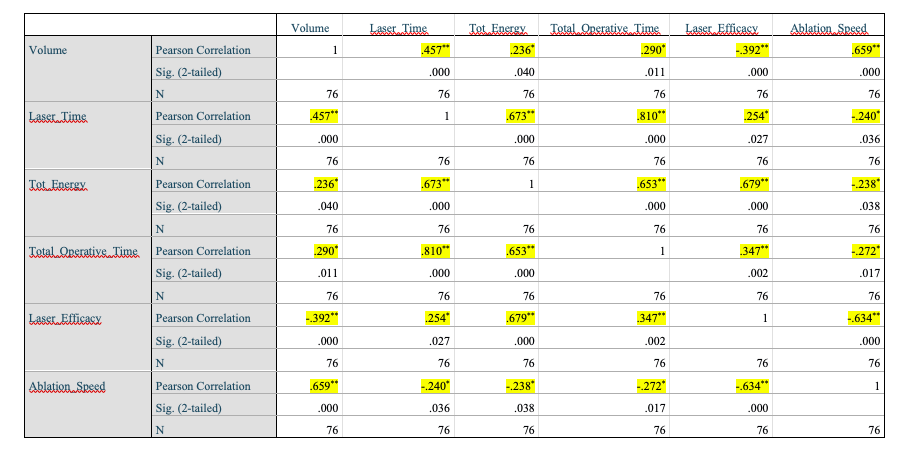Back
Introduction: The Thulium fiber laser (TFL) is a promising new tool in the field of endoscopic laser lithotripsy, but is it efficacious in managing large stones using flexible ureteroscopy remains to be seen. Our objective was to analyse the clinical efficiency of TFL in large volume stones during retrograde intrarenal surgery.
Methods: Patients with large volume renal stones (>1000mm3) and size of 15-25mm, operated at two different centers, from May 2020 to April 2021, were enrolled in this study. Retrograde intrarenal surgery was performed using 60W Superpulse thulium fiber laserTM (IPG Photonics, Russia). Demographic data, stone parameters, lasing time, total operating time were recorded, laser efficacy(J/mm3) and ablation speed(mm3/sec) were calculated. Complications were assessed using Clavien Dindo grading. NCCT KUB was done at 1month post operatively to calculate stone free rate.
Results: A total of 76 patients were included and analysed in the study. Mean stone volume was 1860.79 ± 1172.61 (1169.27-2193.25) mm3, mean stone density was 1099.80 ± 313.65 (875.00-1317.00) HU, mean laser time was 537.79 ± 689.89 (21.00-1080.00) sec, mean total operating time was 43.38± 12.96 (35.00-51.25) min, mean laser efficacy was 20.30 ± 15.5 (8.88-25.57) J/mm3, mean ablation speed was 1.32 ± 0.7 (0.82-1.64) mm3/sec. A strong positive correlation between stone volume and ablation speed (r = 0.659, p = 0.000), a moderate negative correlation between volume and laser efficacy (J/mm3) (r = -0.392, p = 0.000). With increasing volume of the stone, J/mm3 decreased significantly and ablation speed increased significantly (p < 0.001). Complications occurred in 21.05% (16/76) patients, most of which were Clavien grades 1-2. Overall SFR is 96.05%.
Conclusions: With an increase is stone volume, laser efficiency increases as less energy is required to ablate every mm3 of stone. SOURCE OF
Funding: none


Moderated Poster Session
Session: MP23: Stone Disease: Surgical Therapy (including ESWL) I
MP23-12: Clinical Efficiency of Thulium fiber laser for RIRS in large volume stones (15-25mm) –- A Multicentric experience
Friday, April 28, 2023
3:30 PM – 5:30 PM CST
Location: S504

Abhishek DR Singh, M.S, MCH, DNB (he/him/his)
Muljibhai Patel Urological Hospital, Nadiad, Gujarat , India
Poster Presenter(s)
Introduction: The Thulium fiber laser (TFL) is a promising new tool in the field of endoscopic laser lithotripsy, but is it efficacious in managing large stones using flexible ureteroscopy remains to be seen. Our objective was to analyse the clinical efficiency of TFL in large volume stones during retrograde intrarenal surgery.
Methods: Patients with large volume renal stones (>1000mm3) and size of 15-25mm, operated at two different centers, from May 2020 to April 2021, were enrolled in this study. Retrograde intrarenal surgery was performed using 60W Superpulse thulium fiber laserTM (IPG Photonics, Russia). Demographic data, stone parameters, lasing time, total operating time were recorded, laser efficacy(J/mm3) and ablation speed(mm3/sec) were calculated. Complications were assessed using Clavien Dindo grading. NCCT KUB was done at 1month post operatively to calculate stone free rate.
Results: A total of 76 patients were included and analysed in the study. Mean stone volume was 1860.79 ± 1172.61 (1169.27-2193.25) mm3, mean stone density was 1099.80 ± 313.65 (875.00-1317.00) HU, mean laser time was 537.79 ± 689.89 (21.00-1080.00) sec, mean total operating time was 43.38± 12.96 (35.00-51.25) min, mean laser efficacy was 20.30 ± 15.5 (8.88-25.57) J/mm3, mean ablation speed was 1.32 ± 0.7 (0.82-1.64) mm3/sec. A strong positive correlation between stone volume and ablation speed (r = 0.659, p = 0.000), a moderate negative correlation between volume and laser efficacy (J/mm3) (r = -0.392, p = 0.000). With increasing volume of the stone, J/mm3 decreased significantly and ablation speed increased significantly (p < 0.001). Complications occurred in 21.05% (16/76) patients, most of which were Clavien grades 1-2. Overall SFR is 96.05%.
Conclusions: With an increase is stone volume, laser efficiency increases as less energy is required to ablate every mm3 of stone. SOURCE OF
Funding: none


